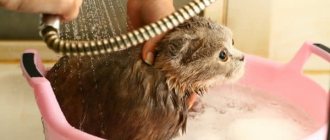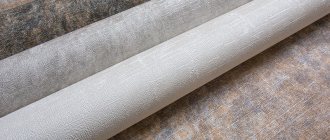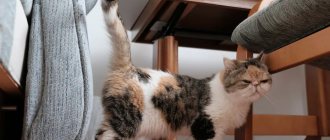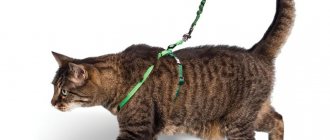Why does a cat tear up furniture and scratch wallpaper?
Seeing the destruction that a cat causes in an apartment, some owners, instead of thinking about how to wean the cat from tearing wallpaper, begin to cruelly punish the animal, not even suspecting that the main share of the blame lies with them.
Cats leave claw marks and pheromones on furniture.
It is important to understand why this happens in order to prevent further “raids” on furniture and wallpaper. These problems rarely arise for those who live “on the ground”: in private households, cottages, and dachas, where the animal can walk freely and independently choose a place where it can sharpen its claws.
Cats don’t tear up wallpaper on purpose, and they certainly don’t do it out of spite.
For those living in apartments, the problem of how to stop a cat from scratching wallpaper is very acute. According to experts, the sources of such behavior can be physiological, behavioral and psychological problems, which, however, can be solved.
Little kittens are taught by their mother cat, but it also happens that even older cats do not know the basic rules of behavior.
Physiology
Although the cat has lived next to humans for many millennia, it remains a predator at its core. Sharp claws are a necessary condition for readiness for attack, hunting or self-defense. And if the owner has not provided personal space for his pet, creating conditions so that the claws are always in order, he will certainly be punished for his inattention with torn wallpaper.
In nature, cats sharpen their claws on trees; in the absence of such in the apartment, they have to look for analogues.
In addition, there are purely physiological problems that must be taken into account when raising a cat:
- sharpening claws is a natural cat need - this way they get rid of the interfering layer of overgrown claws;
- In this unusual way they “mark” the boundaries of their territory;
- This procedure is combined with kneading the muscles that provide flexibility to the cat.
Cats can't help but sharpen their claws.
Psychological problems
Unfortunately, not everything can be explained and justified by physiology. Sometimes psychological problems arise that are associated with the emotional state of a furry friend. These animals are characterized by a rich palette of feelings and emotions: from joyful purring to angry hissing and energetic damage to furniture and wallpaper.
Upholstered or leather furniture, wallpaper - this is what a cat finds first when it does not have a special scratching post.
Moreover, if the cat is angry, he, despite the menacing shouts of his owners, will continue his “dirty deed” with even greater frenzy: in this way he relieves stress, the appearance of which has a variety of reasons:
- one of them is jealousy - cats are rarely indifferent to the need to share the owner’s love and attention with someone else, be it the owner’s dog or the owner’s child;
- anxiety associated with the appearance of an encroacher on the cat’s personal space or territory.
You can make a scratching post yourself or buy it at a pet store.
Behavioral reasons
One of the reasons for ugly behavior is insufficient attention from the owner. Poor care and lack of education can also contribute to violation of cat discipline. Some people believe that a cat that “walks on its own” does not require any training, which is not true.
Some breeders recommend spraying a new toy with a catnip solution.
Its absence is necessarily reflected in the animal’s habits. A small kitten does not understand what can and cannot be done in the apartment - this must be “explained” using available methods, without punishing the baby.
It is quite difficult to stop a cat from tearing up wallpaper.
If the owner initially did not pay due attention to this issue, it will be quite difficult to wean the cat from tearing up the wallpaper, and it will take a lot of time.
Method 2. Use special repellents
irecommend.ru
At the pet store you can also find special sprays with a disgusting odor for the animal. “They were designed to help your cat learn to scratch exclusively on surfaces that are suitable for that purpose,” explains Michelle Burch, veterinary writer and consultant for Catological. “Typically, these products will neutralize the smell of cat pad secretions that are released when scratching, which will discourage pets from leaving marks on your furniture again.”
How to stop a cat from picking everything up
Despite the complexity of the problem, there are many ways to solve it. One of them, which some owners use, is the purchase of anti-scratch claw covers. They will be able to protect furniture from injuries caused by animals.
It will not be possible to completely stop a cat from tearing up wallpaper and other things.
However, do not forget that they can only be used for a short period of time, as these pads deprive the cat of stability. It is difficult for a cat to move with them, because the pads do not allow the claws to be retracted, that is, they deprive the paws of their natural position.
Of course, this accessory does not cause obvious physical injuries, but it causes a lot of inconvenience to the animal, makes it restless, and causes pain during movement.
Attention! It’s worth thinking about whether it’s necessary to torture a cat like this, if there are several gentle methods that will help him get rid of his bad habit.
scratching post
One of the safest and most useful ways is to purchase a scratching post - a simple and safe accessory. Home craftsmen can make it themselves, as the design is simple and straightforward. It is a piece of board attached to the most damaged side of the sofa, to which there is easy access.
But it’s not enough to put a scratching post in the house - you also need to get your pet interested in it.
A scratching post is a compact product that does not take up much space and allows the pet to sharpen its claws in a timely manner without causing damage to the interior of the apartment.
Important! The size of the product should allow the animal to fully stretch out in length, regardless of the location of attachment and shape.
When you get a cat, your furniture and wallpaper on your walls are at risk.
You shouldn’t hope that the kitten will immediately run to the new object and all problems will be solved. However, it is important to understand that you will have to be patient so that the baby gets used to the new accessory and switches his attention from the owner’s wallpaper to the scratching post. To do this you can:
- direct it to the device;
- Run the cat's paws along the surface so that he catches his claw on it.
Nail trimming
Another option for stopping a cat from scratching everything is to remove long nails by trimming them. This will require attention, caution and accuracy from the owner. Before you begin this procedure, you need to familiarize yourself with the procedure for carrying it out. You need to trim the claws very carefully so as not to cause pain to your pet.
Many owners pull out their pets' nails.
If you decide to trim your cat’s claws, it is better to go to a veterinary clinic, where specialists will carry out the procedure quickly and painlessly, in compliance with all veterinary standards.
Note! Some cat owners want to have their cats declawed completely. Such an operation is considered inhumane and can not only cause psychological trauma, but also cripple him, making him, in fact, disabled.
Make the surface unattractive
To combat a cat’s desire to sharpen its claws on a sofa or wallpaper, there are completely safe ways, one of which is to change the structure of the surface, which will become unpleasant for the cat.
You should choose a scratching post based on your pet’s preferences.
This can be done in several ways:
- use “Sticky Paws” tape, which can be purchased at veterinary pharmacies and pet stores;
- some use fine sandpaper, as well as pieces of old suede or artificial leather, glued onto narrow sheets of paper;
- during the next renovation, use materials that cats do not like to decorate places that are most susceptible to destruction by cats: decorative plaster, vinyl and glass wallpaper, laminate, tiles or PVC panels.
Smell repellent
If, despite the actions taken, the cat stubbornly continues to spoil upholstered furniture and wallpaper, you can try to wean it from this bad habit, knowing that there are aromas that a cat’s sense of smell categorically does not accept.
There are modern ways to prevent cats from tearing up wallpaper.
And if so, then you need to know what is the best way to coat the furniture so that the cat does not tear up the home furnishings. Experienced owners offer the following options:
- purchase medications specially developed for this case at a pet store and apply to the most affected areas;
- Essential oils of citrus fruits, which the cat family categorically cannot tolerate, or dried fruit peels will help;
- They have no love for the smells of spices, which can be hung in small bags near the places where the cat commits his “illegal actions.”
Double sided tape
If the answer to the question of how to stop a cat from tearing up wallpaper has not been found in practice, you can try another option by attaching double-sided tape to the places most favorite for damage. Its sticky side, where the paw gets, is unlikely to be pleasant for the furry bully.
To prevent the cat from being tempted by wallpaper and furniture, it needs to be provided with an alternative.
He will soon stop “raids” on the owner’s furniture and will not spoil the wallpaper.
Water use
It's no secret that cats for the most part are not fans of water treatments. If, despite all the efforts of the owners, the pet continues to rob, you can use a spray bottle filled with water. If you spray it directly on his face, then his desire to misbehave will immediately disappear.
Water will scare the animal!
It is better if you spray the liquid at the time of preparing the “crime” or in the process. Punishment, after it has been carried out, will not be understood by the animal.
Is it possible to remove claws?
gfycat.com
This procedure is called an onychectomy , and many experts do not recommend it because declawing can cause health and behavioral problems for the cat . “Problems mean the development of lameness and the appearance of pain when moving.
The animal’s coordination of movements is impaired,” noted Dr. Birch. She also explained that 33% of cats that were fully declawed developed increased aggression and an increase in urinating and defecating outside of the litter box.
see also
20 Photos of Cats That Prove They Can Transform into Any Shape
see also
19 "liquid" cats whose bodies can adapt to any shape
What to do if nothing helps
To solve the problem, if it cannot be solved in other ways, you can use another option that involves unexpected loud sounds to scare away.
Go to radical methods if conventional ones do not help.
Such a factor could be:
- a loud dissatisfied shout: “You can’t!”, “Scram!”;
- the sound of a store-bought rattle;
- use a homemade “scarer” made from a tin can with a handful of coins placed in it.
Use claw covers.
Some people advise using inflated balloons to block the road to a forbidden place. However, not everyone approves of this method, so the choice is up to the owner.
How to avoid mistakes
Many people, when they get a small kitten, perceive it as a living toy, imagining that keeping it will not cause any problems. But when the baby begins to misbehave: he spoils the wallpaper with his claws or “combs” the upholstered furniture, they begin to punish the fluffy, who, oddly enough, becomes more and more naughty day by day and causes more and more damage to the environment.
If your cat has already chosen a piece of furniture or a piece of wall for a claw point, you need to protect this place.
If someone has this exact perception of a cat, it is better not to get one at all. The handsome tailed cat needs to be educated from the first days of his life, and if the time for education is lost, then he needs to be re-educated. To do this, be patient, don’t get angry and don’t punish the baby.
A cat pulls wallpaper much more often if its claws are long enough and it catches on everything.
In order not to raise a small cat into a big egoist and not turn into his slave, it is worth familiarizing yourself with the methods of proper handling of cats. The owner must help the baby learn order, calmly and purposefully.
In nature, cats sharpen their claws on a tree trunk, thus marking their territory.
In addition, it is worth familiarizing yourself with the experience of other owners who highlight the most significant mistakes in raising four-legged animals and not repeating them:
- You cannot punish an animal;
- You should stop trimming your nails yourself and contact a veterinarian for help;
- It is better to keep the old scratching post - the animal may not like the new one, but it is better to place it at the front door or near the bed;
- If the scratching post still needs to be replaced, then objects should be placed next to it that will distract the fluffy’s attention from his destructive actions.
Cats often damage furniture in the house.
Scotch tape will help preserve furniture
If for some reason the previous two methods did not work or did not suit you, try retraining the cat using regular double-sided tape.
The fact is that cats really don’t like it when their paws stick to something, so they won’t sharpen their claws on a sticky surface. To test this method in practice, stick a sufficient amount of tape to the damaged side of the furniture, curtain, or window sill.
Pros:
- the cat will not want to deal with the unpleasant sticky surface and will lose interest in it;
Minuses:
- Because of the sticky tape, the interior will, of course, not benefit; you will have to endure some inconveniences until the bad habit is eradicated.
Rules for caring for a cat
In order for communication with a small cat to bring mutual satisfaction, it is worth knowing the rules of caring for a four-legged cat, which will not require much effort, but love and patience.
Love your pet!
- The first and main condition is personal space, a place for the animal: this can be a house or bedding on which it will sit and sleep. At the same time, you must not forget to shake out dust and wool from it, and also wash it periodically.
- Feed should be varied, nutrition should be balanced.
- If a cat lives in an apartment, from the first days of his life he needs to be trained to use a litter box.
- The coat requires care, especially if the cat is a long-haired breed.
In parallel with accustoming the cat to the scratching post, wean the cat from the places it habitually scratches.
These simple tips will help you raise a gentle, obedient and neat animal that will thank its owner for its care with a gentle purr.











